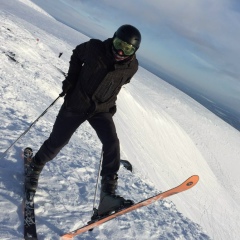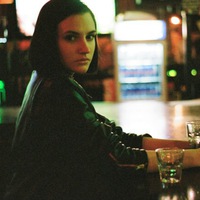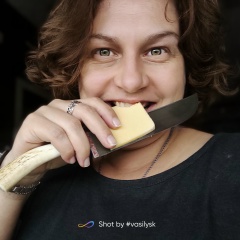В общем закончить прения про платье предлагается следующим объяснением:
Чтобы оценить реальный цвет объекта, нашему мозгу необходимо учесть дополнительные факторы, типа освещения.
Фотка с платьем не даёт однозначного ответа на вопрос об источнике освещения, поэтому его можно расположить как со стороны фотографа (например, вспышка), так и за платьем - например, окно.
Реальные цвета на фотке (речь не о цвете платья, а о цвете на фото!): голубой и грязно-рыжий. Если ваша перцептивная система решила, что источник света расположен за платьем, значит, лицевая сторона платья затенена и чтобы оценить его истинный свет, нужно его осветлить. И вы видите осветлённый голубой и грязно-рыжий - белый и золотой.
Если мозг решил, что свет идёт от вас (фоткаете со вспышкой), значит, платье "пересвечено" и для адектваной оценки нужно его затемнить - получаем синий и бликующий чёрный.
Андрей провёл опрос, который подтвердил предположение: те, кто видит платье белым, считают, что со стороны фотографа нет источника света. А те, кто видит синее - наоборот: http://vk.com/page-47214165_50841449.
В сети мне встретилась офигенная картинка с ламой с однозначно интерпретируемым источником света - солнце светит сзади. По идее новичок должен видеть платье белым. Потом я пытался создать картинки с однозначным светом "от фотографа", но, кажется, у меня не очень получилось. Но ради этих картинок я и написал этот пост, так что наслаждайтесь.
Чтобы оценить реальный цвет объекта, нашему мозгу необходимо учесть дополнительные факторы, типа освещения.
Фотка с платьем не даёт однозначного ответа на вопрос об источнике освещения, поэтому его можно расположить как со стороны фотографа (например, вспышка), так и за платьем - например, окно.
Реальные цвета на фотке (речь не о цвете платья, а о цвете на фото!): голубой и грязно-рыжий. Если ваша перцептивная система решила, что источник света расположен за платьем, значит, лицевая сторона платья затенена и чтобы оценить его истинный свет, нужно его осветлить. И вы видите осветлённый голубой и грязно-рыжий - белый и золотой.
Если мозг решил, что свет идёт от вас (фоткаете со вспышкой), значит, платье "пересвечено" и для адектваной оценки нужно его затемнить - получаем синий и бликующий чёрный.
Андрей провёл опрос, который подтвердил предположение: те, кто видит платье белым, считают, что со стороны фотографа нет источника света. А те, кто видит синее - наоборот: http://vk.com/page-47214165_50841449.
В сети мне встретилась офигенная картинка с ламой с однозначно интерпретируемым источником света - солнце светит сзади. По идее новичок должен видеть платье белым. Потом я пытался создать картинки с однозначным светом "от фотографа", но, кажется, у меня не очень получилось. Но ради этих картинок я и написал этот пост, так что наслаждайтесь.
In general, the debate about the dress is proposed by the following explanation:
To evaluate the real color of an object, our brain needs to consider additional factors, such as lighting.
A photo with a dress does not give an unambiguous answer to the question about the source of illumination, therefore it can be placed both from the side of the photographer (for example, a flash), and behind the dress - for example, a window.
The real colors in the photo (it's not about the color of the dress, but about the color in the photo!): Blue and dirty red. If your perceptual system has decided that the light source is located behind the dress, then the front side of the dress is shaded and in order to evaluate its true light, you need to lighten it. And you see a brightened blue and dirty red - white and gold.
If the brain decided that the light comes from you (take a picture with a flash), then the dress is "overexposed" and for an adequate assessment you need to darken it - we get blue and glare black.
Andrei conducted a survey that confirmed the assumption: those who see the dress in white believe that there is no light source from the side of the photographer. And those who see blue are the other way around: http://vk.com/page-47214165_50841449.
On the net, I met an awesome picture with a llama with an uniquely interpreted light source - the sun shines from behind. In theory, a beginner should see the dress white. Then I tried to create pictures with a clear light "from the photographer", but it seems that I did not really succeed. But for the sake of these pictures, I wrote this post, so enjoy.
To evaluate the real color of an object, our brain needs to consider additional factors, such as lighting.
A photo with a dress does not give an unambiguous answer to the question about the source of illumination, therefore it can be placed both from the side of the photographer (for example, a flash), and behind the dress - for example, a window.
The real colors in the photo (it's not about the color of the dress, but about the color in the photo!): Blue and dirty red. If your perceptual system has decided that the light source is located behind the dress, then the front side of the dress is shaded and in order to evaluate its true light, you need to lighten it. And you see a brightened blue and dirty red - white and gold.
If the brain decided that the light comes from you (take a picture with a flash), then the dress is "overexposed" and for an adequate assessment you need to darken it - we get blue and glare black.
Andrei conducted a survey that confirmed the assumption: those who see the dress in white believe that there is no light source from the side of the photographer. And those who see blue are the other way around: http://vk.com/page-47214165_50841449.
On the net, I met an awesome picture with a llama with an uniquely interpreted light source - the sun shines from behind. In theory, a beginner should see the dress white. Then I tried to create pictures with a clear light "from the photographer", but it seems that I did not really succeed. But for the sake of these pictures, I wrote this post, so enjoy.







У записи 52 лайков,
7 репостов.
7 репостов.
Эту запись оставил(а) на своей стене Иван Иванчей







![Андрей Четвериков [chetvericov.ru] Андрей Четвериков [chetvericov.ru]](https://sun9-67.vkuserphoto.ru/impg/_nb2NhfE_jv_qxgCOx2FOjBdyXDTRZoApoB7ow/mLrG7mi-98Y.jpg?quality=96&as=32x32,48x48,72x72,108x108,160x160,240x240,360x360&sign=027f3a6ab46c06112aaff21998198fb8&u=Gsgve_JGBJIKsdpKeqSEdgzA8QnKETeW3ILhU4seZNI&cs=200x200)





























































